April 15-21, 1999:
In Search of the Old Ones
Grand Gulch, Utah
Page 3
| Left camp on day four just after 7 A.M. This day would be the warmest
yet. An hour of hiking brought us to Dripping Canyon where we found pictographs
about 100 yards in. Shortly afterwards we continued down the main gulch
trail, soon coming to Cow Tank Canyon. Talked to a guy from Seattle who
was camped at the junction with about five others. They had started from
Collins Canyon--essentially the opposite side from where I had started.
I gathered from him then (and later when I met him again in Blanding!)
that the dynamics of their group size was not very conducive to site exploration. |
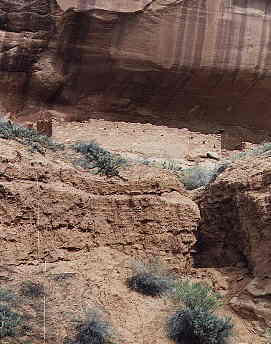 |
Venturing up Cow Tank Canyon we once again found pictographs about 100
yards in. Then we came on a ladder (!) going up an otherwise unascendable
dryfall. An old tree limb ran alonside the ladder--the ladder not quite
reaching the top of the lip, the limb was for the final step to the top.
It was a bit scary, and it ended up not really being worth the effort as
the canyon became quite narrow quickly and I turned around. Although I
didn't hear Sam, the people camped at the mouth of the canyon reported
that Sam was getting some great echo effect with his plaintive howling.
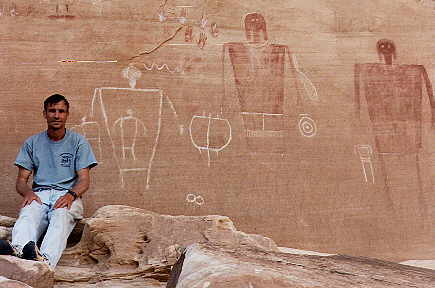 |
Continuing down the main gulch
trail I soon came on the famous "Big Man" pictograph, visible for nearly
a mile from the north. Sam Waited down below while I climbed up to the
wall. A father/son pair asked me to photograph them together and we struck
up a conversation.
|
The son was very knowledgable about Anasazi
and recommended a couple books that I later purchased at the Kane
ranger Station and have since read: Cowboys and Cavedwellers by
Fred Blackburn, and Anasazi Basketmaker: Papers from the 1990 Wetherill
Grand Gulch Symposium. Both books cover the early attempts at archaeological
exploration by Richard Wetherill among others. These early amatuer archaelogists
have been often maligned over the years for transporting vast amounts of
ancient burial remains, pots, and baskets to now often obscure museums
or private collections, their archeological significance lost, as the location
from which they came was often not recorded. The two books go a long way
towards piecing together the original expeditions and locating artifacts
in various museums and identifying where they came from.
| The son asked me if I had read "Roberts book". I had, he was referring
to In Search of the Old Ones by David Roberts. He also told me about
a ruin site opposite Polly's Island where he had found a signature from
Wetherill and others and the date of 1891. Without his direction I never
would have found the site (shown at right). |
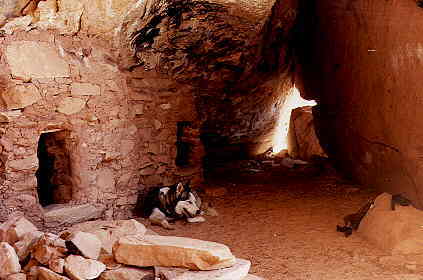 |
Polly's Island is a large sandstone block rising from the center of
the confluence of Grand Gulch and Polly Gulch. A family was camped at the
mouth of Polly Canyon, where I had intended to camp that night. Solitude
is important so I didn't camp there after all. All I wanted to hear as
the evening progressed was the occasional bird, the buzzing of a fly or
bee or hummingbird, or the wind in the trees. Dropping my pack I circled
the island through a maze of mesquite bushes in the oppressive afternoon
sun, finally spotting the ruin as described by the son. A large wall of
sandstone blocks leaned against the alcove forming a shade cover. The son
seemed to think the Anasazi had "muscled" the blocks up there in a mystery
not unlike the pyramids. To me it was apparent that the blocks had slid
from above on the canyon wall. The main reason I believe they slid from
above is the last piece of the wall on top is not necessary as it is completely
above the overhang and not neccessary for shade. The Anasazi obviously
came later and took advantage of the natural shelter from the sun afforded
by the sandstone blocks.
Sam and I took relief from the sun ourselves--I read from L:onesome
Dove for half an hour while Sam dozed.
| We had to push after that to make "Big Pour Off Spring" another 3 miles
down trail. It was brutal and at one point Sam flopped down in the shade
and refused to continue. |
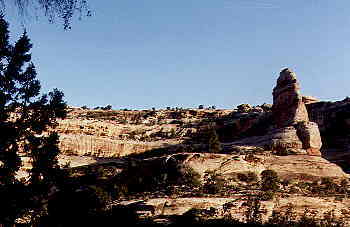 |
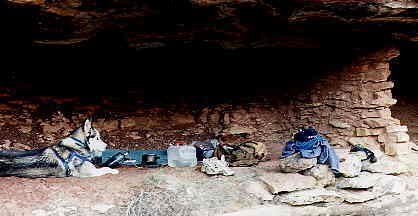 |
We camped under a ledge where it was nice and cool. A sharp contrast
to the brutal sun that had tormented us that afternoon. The Ancient Ones
knew what they were doing when they situated their homes. The evening time
is nice to gaze out at the view and watch shadows and light change on the
opposite canyon wall. |
| The morning of day five I left camp just before 7 A.M. clad in running
shorts, singlet, and hip pack for the run to Bannister Ruin. It only took
us twenty minutes--we were much closer than I had thought. |
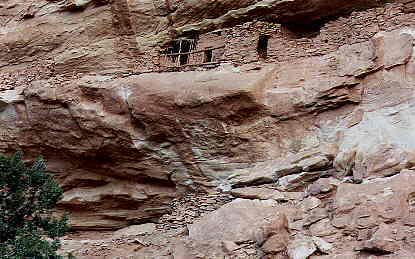 |
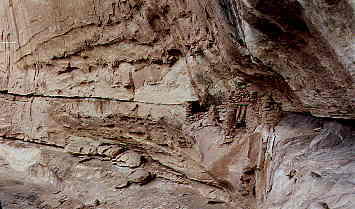 |
The ruins recieved their name from the obvious poles exposed in parallel
with the ground--like bannisters. I climbed up level with the ruin, but
the way to the ruin was blocked by a wall too exposed for me to risk
going around.. |
| Sam and I, although quiet as mice, aroused a couple camped nearby.
After a few minutes, Tim and Sue from Santa Cruz invited me over for coffee.
Tim is a geologist, doing private consulting for a lumber company and Sue
is a Marine Biologist. We compared notes on "must see" ruins and I learned
of a couple "must see" sites I had missed on my way down, including the
"railroad" panel that I never would have found without their advice. |
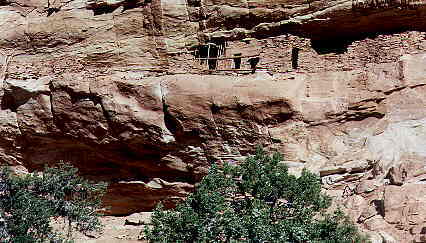 |
 |
Kiva at the Bannister ruin site. |
| View looking back towards my camp site of the night before from
the other side of the canyon. Note the spire at the left of the photo. |
 |
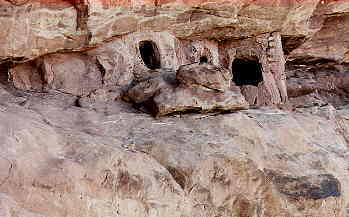 |
These granaries were my reward for venturing
off trail to the above viewpoint. |
| Stopped here for two hours during the worst of the hot afternoon--read
my book and cooked up my one meal for the day of rice. I gave Sam half.
For extended backpacking trips I'm a minimalist. Next time I'll need to
bring more dog food though. Sam is not into going without. |
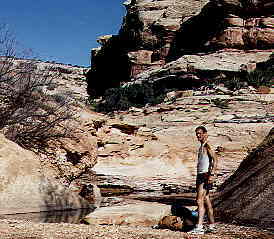 |
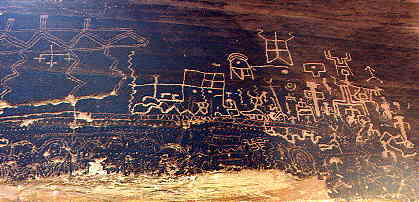 |
I searched for the Railroad panel for some time, but didn't find it
until Tim and Sue came up the trail and spotted it.
Later after I had thought they had continued up the trail, they returned
with some extra food for me! That morning they had given Sam some left
over spaghetti and I had told them we were rationing our food--one package
of rice and one power bar a day. Sam had dog food for two more nights.
They gave me split peas for soup, dried banana chips, and dried papaya. |
| I climbed to the top of the canyon wall from the Railroad Panel.
Looking down I spotted Tim and Sue again. I called "hello Tim". He looked
around, but not up. When I said "up here". His eyes went up, but not to
my level. When I said "way up!" he was quite surprised to see me up so
high. |
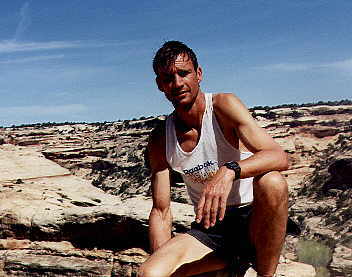 |
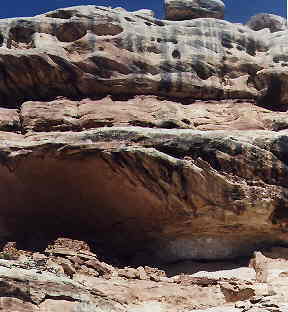 |
Later I climbed around a large cirque
near Big Pour Off Spring, first climbing to a mid-canyon wall point where
I thought some structures might be. It was quite an effort and I was a
bit exposed in places, but found no ruins. After going to the opposite
side of the cirque and climbing high I then spotted a couple of small granaries
on the opposite wall. |
Page
4















